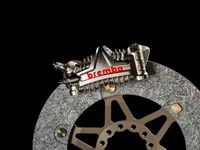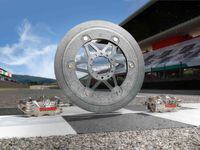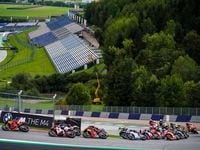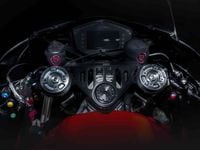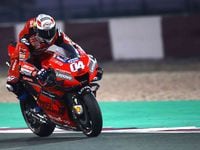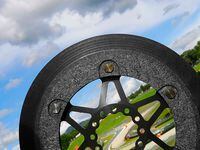The Five Ingredients of Brembo Braking Systems
From the racetrack to the road
While approaching the famous turn 4 at Spielberg Circuit in Austria, MotoGP bikes can brake from 286 kph (178 mph) to 84 kph (52 mph) in 4.5 seconds over 215 meters (705 feet), a deceleration equal to 1.5 Gs, with a force on the lever of only 5.6 kilos (12.3 pounds). How is it possible? This is only one of the challenges that Brembo has to face at the Austrian track, one of the most severe for the Italian brake manufacturer.
We spoke to Brembo MotoGP Trackside Engineer Andrea Pellegrini about how it is possible for a standard braking system to achieve such incredible braking performance. Here are the five key ingredients of Brembo braking systems that determine unrivaled performance.
In ruthless MotoGP competition, every gram counts.
“The teams keep asking for lighter components without compromises in performance. This has been a primary focus,” Pellegrini says. “My background is in Formula 1, and interestingly, I’m seeing MotoGP following the same path around 10 years later. At the request of the teams we have developed lighter disc carriers that allow us to save around 40 grams. The new caliper is also lighter while maintaining the same stiffness. Saving weight from the discs and the wheels as well, we can arrive at reductions of 1 kilo [2.2 pounds], which is a lot.”
Aerodynamic development is also involved in the braking system. At the start of the 2020 MotoGP World Championship, Brembo introduced the new GP4 caliper, a four-piston radial Monoblock unit machined from a solid piece of aluminum. This new caliper incorporates new fins on its external body to ensure more efficient cooling of the caliper, and consequently, the entire braking system.
As modern MotoGP bikes strive for higher top speeds, they also place more demand on the braking system, resulting in increased temperatures. “In some corners, temperatures of carbon brake discs reach peaks of 1,000 degrees Celsius,” Pellegrini says. “This is why ventilation is needed. [We incorporate cooling] so that the brakes can work at an average temperature of 600–700 degrees, with peaks of 800 degrees.”
That’s one piece of the puzzle. According to Pellegrini, every component of the system has to be in its optimum temperature range for maximum performance. “The winglets incorporated into the caliper, together with the air ducts, decrease the temperatures of the calipers, which need to work below 200 degrees Celsius for consistent performance throughout the race distance.”
If weight, size, and temperature are real challenges for the Brembo engineers, so is the track layout. Analyzing the demands of each racetrack is crucial in determining the choice of braking components. Each circuit on the MotoGP calendar is ranked from grade 1 to 5.
For example, the most demanding circuits in regard to brake performance are the Twin Ring Motegi in Japan, the Red Bull Ring in Austria, and Malaysia’s Sepang International Circuit. Here, engineers recommend using larger-diameter 340mm discs to cope with the severe forces seen in deceleration from speeds over 300 kph down to 100 kph.
Other circuits, like Australia’s Phillip Island or the Netherlands’ Assen, require less braking force. There, 320mm discs are up to the task.
Every rider has a unique style, which affects the demands on the braking system, says Pellegrini. “Each rider has his unique style, but we can divide them into two macro categories: Those who brake earlier and with less intensity, but carry brake pressure for a longer period of time; and those who use more brake pressure prior to corner entry, but over a shorter time. These two riding styles directly affect the temperature and, consequently, the carbon wear.”
Brembo collects and analyzes the data of all MotoGP riders. Among the late brakers, including Valentino Rossi, Marc Márquez, and Andrea Dovizioso, each has his own preference.
Ducati’s Dovizioso was a pioneer in using a thumb-actuated rear brake, which has since been adopted by a majority of his competitors. “I tested it for the first time when I was at Repsol Honda HRC, but I used it regularly when I switched to Ducati. I’m happy to see that afterward the majority of the other riders started to use it. I mainly use it in the right-hand turns, because you cannot use the rear brake [pedal] with the foot in the middle of the corners.”
Racing has always been the perfect laboratory for testing the latest technology, which is later carried down to production motorcycles. The GP4-MS caliper, derived from Brembo’s MotoGP endeavors, is an example.
Designed for track enthusiasts and those who seek innovative performance, the Brembo GP4-MS is inspired by the Monoblock caliper developed for MotoGP. It comes equipped with four 30mm-diameter pistons, nickel surface finishing, and an optimized topological outer design that aims to strike a balance between rigidity and low weight. The kit also includes the eye-catching heat-sensitive adhesive stickers used in MotoGP to assess the operating temperature reached by the calipers after each session.
The future of braking technology? Carbon ceramic. These materials are said to offer more consistent and efficient performance at a lighter weight.
Brembo is actively studying this new material for everyday use, but recognizes the challenge of required warm-up time. For example, the brakes used in MotoGP do not work until the discs reach a temperature of 300 degrees Celsius, which explains why racers “ride the brakes” while exiting pit lane.
Pellegrini goes on: “Requirements for the street are different from those in racing, as brakes need to be efficient when exiting a home garage. There is not enough time or space to warm them up, so we use steel brakes per regulations in the World Superbike, Moto2, and Moto3 championships. This is a reason why these categories are also important as a laboratory for testing new solutions that apply to street products.”






